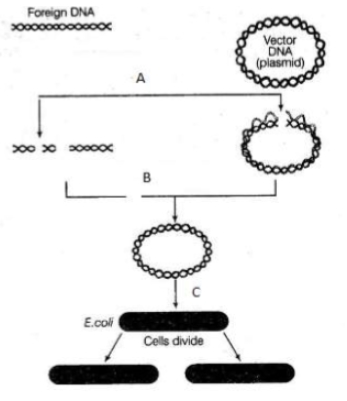What is true A,B and C in the given diagrammatic representation of rDNA technology ?

I. At A same restriction enzyme is used to cut both foreign and vector DNA
II. The enzyme used at B is DNA ligase
III. Step C can be called as transformation
1. I and II only
2. I and III only
3. II and III only
4. I,II and III

According to traditional view which of the following can be kept under the process or form in Biotechnology?
A. Test tube baby
B. DNA vaccine
C. Making of wine
D. Correcting a gene
If you transfom a cell with an alien piece of DNA only, What is the possibility?
1. This alien piece becomes a part of host genome.
2. It doesn't become a part of host's genome but keeps on replicating
3. The cloning of gene won't get affected in the absence of Origin of replication.
4. Multiple identical copies of alien piece of DNA can be formed irrespective of its integration into host's genome.
In the year 1963, the two enzymes responsible for inhibiting the growth of bacteriophage in E. coli were isolated. One of them was
1. Ligase
2. Polymerase
3. Molecular scissor
4. Antibiotic resistance enzyme
Today we know more than …….. restriction enzymes that have been isolated from over……..strains
1. 700; 350
2. 900; 230
3. 600; 270
4. 550; 210
Restriction endonuclease
A. Directly recognizes specific sequence
B. Makes the cut at sugar-phosphate core.
C. Comes under nuclease
D. Both A and C
Which of the following step is first one in order to separate DNA fragments?
A. Running of gel
B. Staining of gel
C. Elution
D. Setting of gel
In a DNA gel the fragment of 2kb and 3kb will be
1. 2kb nearer to cathode while 3kb nearer to anode
2. 2kb closer to wells while 3kb towards the opposite ends
3. 2kb closer to opposite end of gel while 3kb closer to well
4. 2kb away from cathode while 3kb towards anode
If I want to check the expression of my gene, then I should use
A. Vectors supporting high copy number
B. Vectors supporting low copy number
C. No need to bother about copy number
D. Vectors with strong Ori
Agrobacterium tumifaciens
1. A pathogen of angiosperms
2. It is able to deliver a piece of DNA known as T-DNA to transform bacterial cell and direct the cell to produce chemicals required by the pathogen
3. Ti plasmid of it is now modified into an expression vector
4. It's Ti plasmid is modified into a cloning vector which is no more pathogenic






